Electric camper jacks can handle loads up to 2,800 pounds, making them significant parts of your camping setup. However, these powerful systems can quickly develop problems when seals deteriorate, dirt gets in, or moisture causes damage.
Regularly maintaining your camper’s electric system protects your investment and prevents breakdowns. The jacks will give you reliable performance when you clean the rod, check for rust, and apply the right synthetic blend grease. You’ll find expert maintenance tips to help keep your jacks running smoothly and extend their life.
Table of Contents
Understanding Electric Camper Jacks and Their Components
“The correct jack also impacts trailer maintenance as it ensures stability and proper weight distribution whether the trailer is connected to the tow vehicle or not.” — Blueswift Axles, RV and trailer parts manufacturer
Electric camper jacks combine convenience and reliability to make your camping adventures easier. These power-driven systems come in different configurations that match your camping needs and setups.
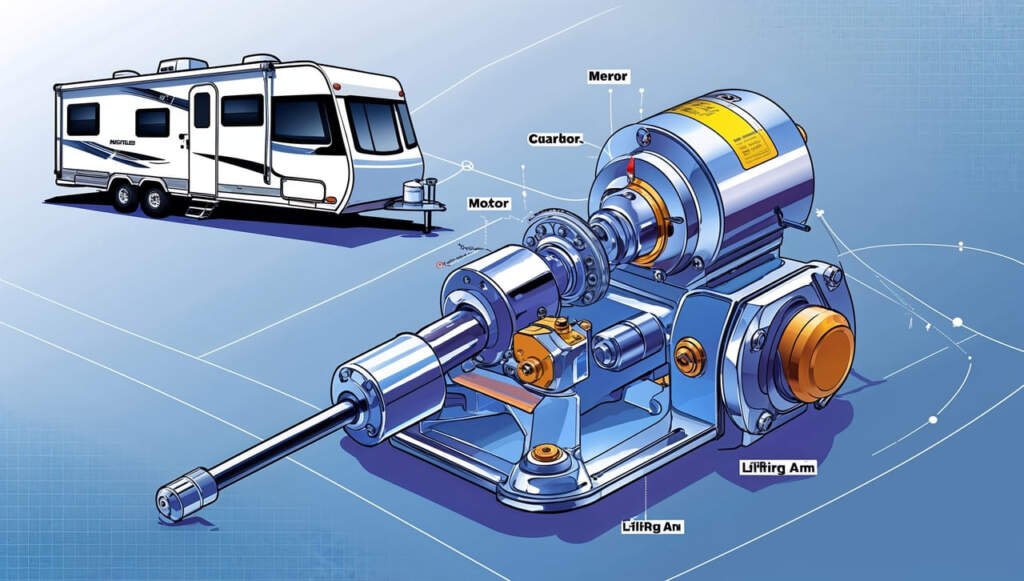
Types of electric jacks for campers
Truck camper owners often prefer corner-mounted electric jacks. These units attach to all four corners of your camper and provide stable support that’s easy to operate. On top of that, the Stable-Lift system lifts any camper in or out of a truck bed in just two minutes.
These electric jacks are powered by your truck’s electrical system or an onboard battery bank. Some advanced models let you control operations through smartphone apps. While the upfront cost is higher, these systems are worth the investment if you camp frequently.
Key components that require maintenance
Electric camper jacks need several vital components working together smoothly:
- Powerhead Assembly: The system’s heart that houses the electric motor and control mechanisms
- Receiver and Transmitter Units: Let you operate remotely and communicate between components
- Jack Legs and Tubes: Bear weight and keep everything stable
- LED Lighting Systems: Help you set up at night
- Drop Leg Components: Give you more lift range and adjustment options
The motor system uses IP-rated switches for safety. Many models also feature water-resistant controls to handle bad weather.
How electric jacks differ from manual systems
Electric jacks beat manual ones in several ways. They remove all physical effort from the process. You can complete tasks in under 2 minutes instead of cranking by hand for 30+ minutes.
Here’s how they compare:
| Feature | Electric Jacks | Manual Jacks |
|---|---|---|
| Weight Capacity | 5,000+ lbs | 1,000-5,000 lbs |
| Operation Time | Under 2 minutes | 30+ minutes |
| Control | Precise electronic | Manual effort |
| Additional Features | LED lights, memory settings | Simple operation |
Modern electric jacks come with safety features like:
- Wider bases for better stability
- Advanced anti-slip mechanisms
- Automatic shut-off protection
- Emergency backup systems
Electric jacks usually last 7-10 years and are well-maintained. Premium models often come with 2-5-year warranties. Many systems also have a manual override feature to keep working even if electrical problems occur.
The drive system uses either a high-torque motor connected to a worm-threaded drive shaft or an electric-over-hydraulic system with solenoid valves. These mechanisms work consistently, regardless of the weather or load weight, which makes them great for heavier campers and regular use.
Signs Your Electric Camper Jacks Need Maintenance
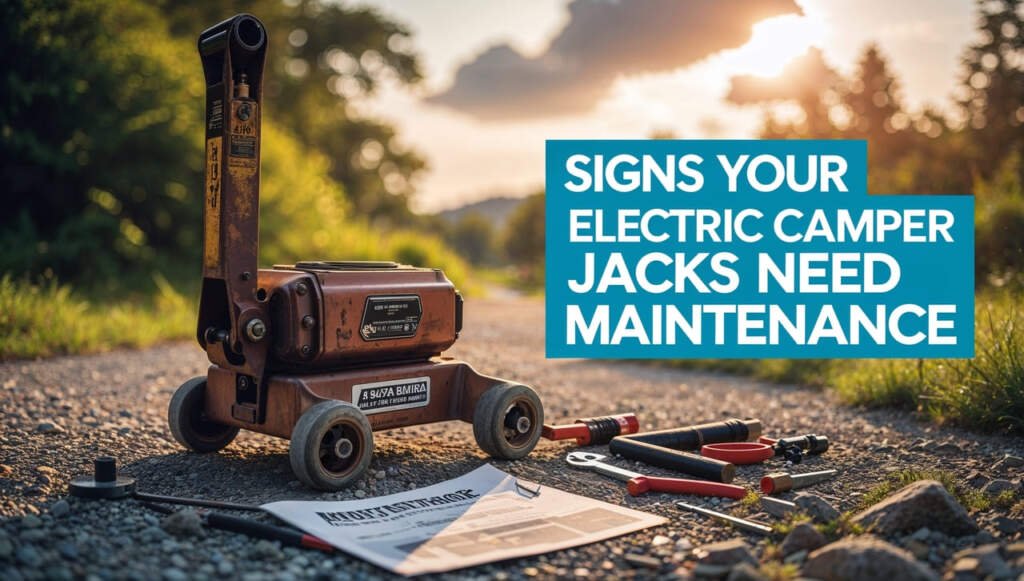
Your electric camper jacks need regular attention to spot warning signs. These indicators help you avoid unexpected breakdowns during your camping trips.
Unusual noises during the operation
Your electric camper jacks might make strange sounds that signal developing problems. A distinct popping or thumping noise while lowering operations suggests potential gear problems while grinding sounds or intermittent clacking noises point to internal mechanical stress.
Look out for these specific sound patterns:
- Clutch ratcheting at travel endpoints (normal safety feature)
- Continuous grinding during operation
- Intermittent clicking sounds during normal travel range
Slow or inconsistent movement
Sluggish performance from your electric jacks needs immediate attention. A well-functioning system should lift your camper smoothly without stopping. Watch for these movement issues:
- Taking over two hours to lift the trailer for hookup
- Stopping after lifting only an inch
- Operating in short, inconsistent bursts
These signs usually point to power supply problems or internal mechanical failures. Slow movement might indicate worn components or poor lubrication, even with a fully charged battery.
Visible corrosion or damage
Regular external checks reveal important maintenance needs. Water getting inside can cause substantial internal damage, leading to seized bearings and structural problems. These areas need regular inspection:
- Bolt connections and brake mechanisms
- Ground wire attachments
- Internal bearing components
- Threaded rod surfaces
Corroded electrical connections can substantially disrupt performance. To prevent future oxidation, clean all ground connections and apply dielectric spray.
Electrical connection issues
Power problems have several distinct symptoms. The jack’s LED indicator light should be your first check. Note that a working light doesn’t guarantee proper operation since it uses minimal power compared to the motor.
You might encounter these electrical issues:
- No response despite power presence
- Operation only with shore power
- Functioning lights but non-working motor
- Intermittent power loss
Electric jacks typically draw fourteen amps when raising and six amps when lowering a 4,000-pound camper. Any major deviation from these power patterns needs investigation.
Malfunctioning jacks can suffer more damage if you keep using them. Depending on the problem’s complexity, do basic maintenance checks or get professional help when you notice these warning signs.
Essential Maintenance Tasks for Electric Camper Jacks
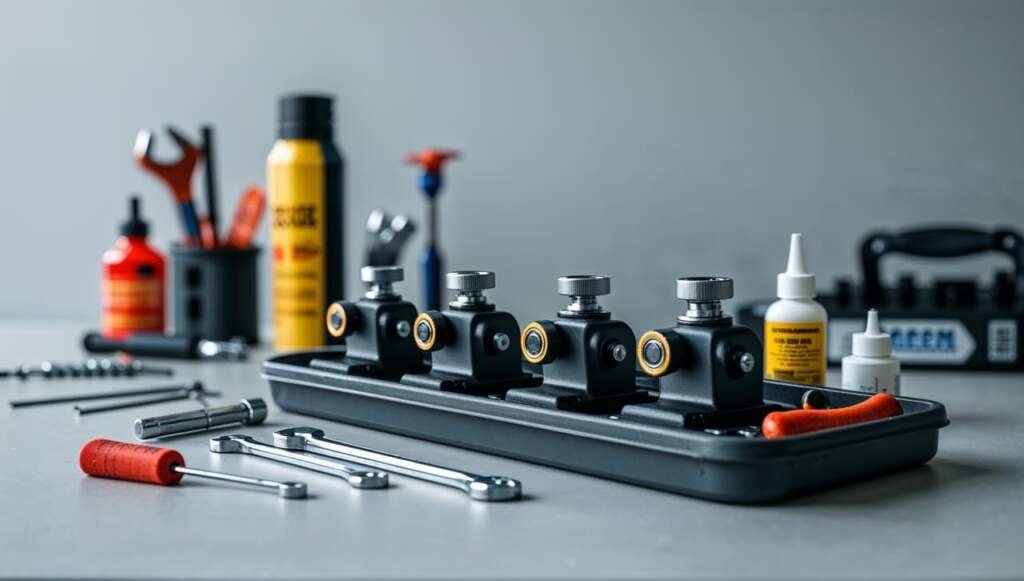
Your electric camper jacks need proper maintenance to work reliably for years. A systematic approach to maintenance will prevent breakdowns and extend the life of your equipment.
Cleaning the jack legs and tubes
Raise your camper all the way up to reach all jack parts. Clean both inside and outside jack tubes with soapy water. Look for rust spots and remove them with sandpaper. After you clean:
- Protect against future rust with Rustoleum paint or metal silver spray
- Apply liquid wax products like Mercury’s Corrosion Guard or McGuires to protect the exterior
- Maybe even spray wax monthly in tough environments
Lubricating moving parts and gears
Different jack types need different lubrication based on how you use them. Mechanical jacks work best with annual 10W40 oil applications. Of course, keep the electric motors free of lubricants – just keep the leg clean.
To work on internal parts:
- Take off the jack foot to get to the screw shaft
- Put wheel bearing grease on gears
- Apply 90# gear oil to the screw mechanism
- Move jacks up and down so lubricant spreads everywhere
Checking and replacing seals
Seals need to be checked often to prevent moisture and damage to parts. The rubber boot at the bottom of jacks is a vital barrier against dirt and grime. The remote control’s rubber gasket between plastic case halves also needs attention.
Inspecting electrical connections
Electric jacks’ power systems need special care. Your system should draw about:
- 14 amps when raising the camper
- 6 amps when lowering
The receiver box LED lights tell you what’s happening:
- Green means it’s going up
- Red shows it’s going down
- No lights mean you likely need new fuses
When each season starts, put fresh batteries in your remote. Clean it with a slightly damp cloth instead of getting it too wet.
Run your jacks all the way up and down once a month to spread lubricant and keep the system healthy. If you camp where there’s lots of sand, salt, or humidity, you’ll need to do maintenance more often.
Seasonal Maintenance Schedule for Truck Camper Electric Jacks
“If you keep your camper on your truck, make sure that you run the jacks up and down twice a year to keep them lubricated.” — Don Cochran, Customer Service Manager at Happijac
Spring is the best time to create a detailed maintenance schedule for your electric camper jacks. A well-laid-out routine will give you the best performance during the camping season.
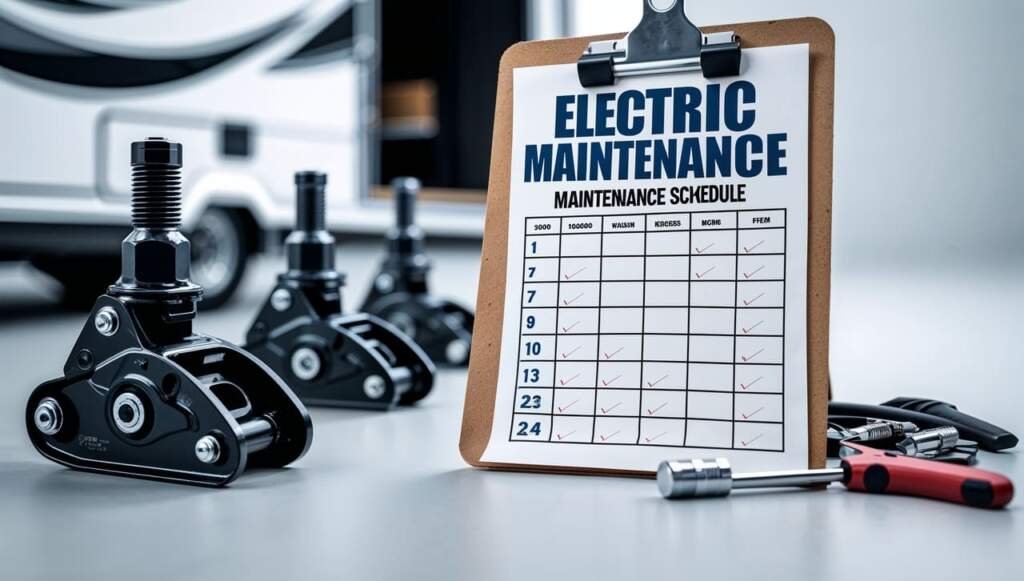
Pre-trip inspection checklist
Before you start your camping adventure, complete these important checks:
- Get into all jack parts for visible damage
- Test electrical connections and LED indicators
- Check if the operation is smooth through full extension
- Check battery levels and charging systems
- Look at mounting brackets and hardware
Monthly maintenance tasks
Regular upkeep is vital to preventing unexpected failures. Expert advice says you should run your jacks at least once every month by raising and lowering them completely. This helps spread grease across the system and keeps everything working well.
To take care of your jacks monthly:
- Clean exterior surfaces with mild soap
- Apply spray wax to protect
- Test manual override mechanisms
- Listen for unusual sounds
- Check electrical connections
Seasonal deep cleaning procedures
The yearly maintenance should happen in spring before the camping season starts, and several significant steps are needed. Raise your camper fully and wash each jack with soapy water. Sand off any rust spots you find right away.
After cleaning:
- Apply Rustoleum paint or metal silver spray to affected areas
- Let it dry properly
- Finish with liquid wax application using products like:
- Mercury’s Corrosion Guard
- Mother’s Polish
- McGuire
- Turtle Wax
Experts recommend these options for winter storage:
- Place camper on a platform (sawhorses or wood base) close to ground level
- Keep the camper mounted on a truck with fully retracted jacks
- If storing on jacks, keep minimal height from the ground
We focused on areas with high sand, salt, or humidity exposure that need more frequent maintenance. This helps curb environmental factors that speed up wear.
Your camper should sit as low as possible during winter to reduce stress on sidewalls. The weight transfers to the floor structure instead of putting pressure on the camper’s sides.
Note that maintenance frequency depends on how often you use your camper and the environment. Coastal areas or places with high humidity need more attention to stop corrosion and keep operations reliable throughout the season.
DIY vs. Professional Maintenance for Electric Camper Jacks
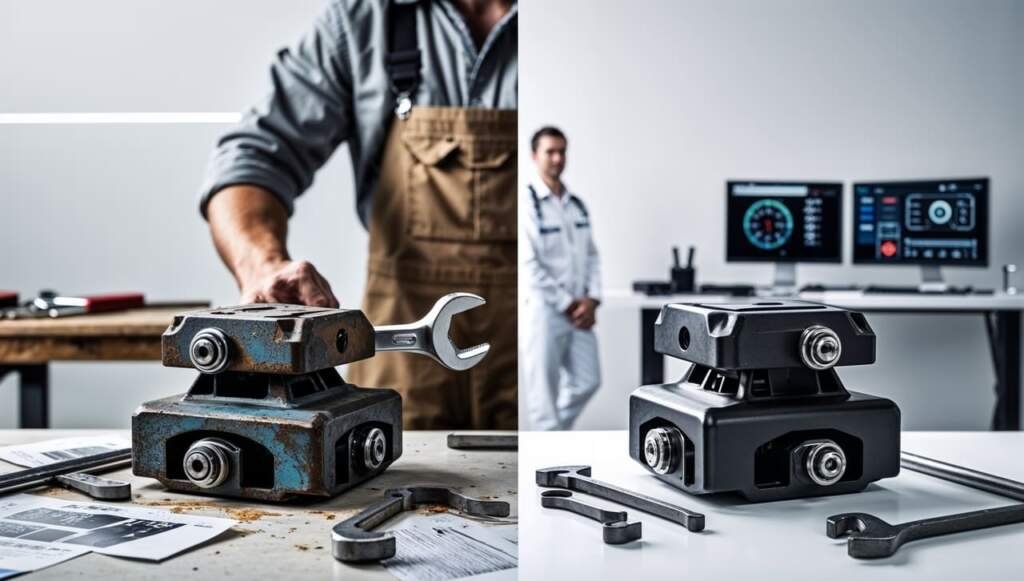
Smart decisions about electric camper jack maintenance start with knowing what you can handle yourself. Your skill level determines which tasks you should tackle and which ones need professional help. This approach saves both time and money.
Tasks you can safely perform yourself
Most camper owners can handle simple maintenance tasks without any trouble. A good starting point is cleaning the jack legs with warm soapy water and removing rust spots with sandpaper – you don’t need much technical know-how. The next step is to apply protective coatings:
- Rustoleum paint or metal silver spray
- Liquid wax (Mercury’s Corrosion Guard or McGuires)
- Monthly spray wax applications
Electrical maintenance is straightforward, too. You can inspect wiring connections and clean them with an emery cloth and electrical contact cleaner. Regular checks of battery charge levels and remote control functionality are the foundations of keeping your jack working well.
When to seek professional help
You’ll need expert help in specific situations. A certified technician should look at your jack if you notice:
- Hydraulic fluid leaks
- Bent jack components
- Severe rust damage
- Motor failure
Your manufacturer might insist on professional inspection if your electric jack is damaged physically. Complex electrical problems are nowhere near DIY territory—they need specialized diagnostic equipment and expertise.
Cost comparison of DIY vs. professional service
A budget-friendly approach needs a clear picture of maintenance costs. Here’s what you can expect:
| Maintenance Type | DIY Cost Range | Professional Service Cost |
|---|---|---|
| Basic Cleaning | $20-30 | $75-100 |
| Electrical Check | $15-25 | $90-150 |
| Component Replacement | $150-300 | $400-600 |
Mobile services come to your location, which is convenient but adds 15-25% to standard service costs. Regular DIY maintenance is a great way to avoid expensive professional repairs.
Your cost planning should include:
- Warranty coverage limitations
- Availability of certified technicians
- Emergency service premiums
- Travel distance charges
Manufacturers provide detailed maintenance guides that help owners confidently handle routine tasks. However, repairs beyond your expertise might void your warranty or cause more damage.
Professional technicians are worth their cost, especially when you have:
- Complex electrical diagnostics
- Hydraulic system repairs
- Structural damage assessment
- Warranty-covered work
Conclusion
Electric camper jacks are one of the most important investments in your camping setup. Good maintenance of these powerful systems will help you avoid getting pricey repairs and give you reliable performance during your adventures.
Simple maintenance tasks greatly affect the life of your system. You must clean jack legs, check electrical connections, and lubricate moving parts. Your quick response to warning signs like unusual noises or slow movement helps catch problems before they turn serious.
A consistent maintenance schedule that fits your camping frequency and environment will protect your investment. Of course, many maintenance tasks work well as DIY projects, but knowing when to ask for professional help prevents damage and protects your warranty.
Note that properly maintained electric camper jacks last longer and provide stable, reliable support that you need for safe and fun camping trips. These maintenance practices will help you maximize your jacks’ performance and lifespan.
FAQs Related to Electric Camper Jacks
How often should I maintain my electric camper jack?
Regular maintenance is key. To keep your electric camper jack functioning smoothly, check it every 3-6 months for wear, lubricate moving parts, and ensure electrical connections are secure.
What’s the best way to prevent my electric camper jack from rusting?
Apply a rust-resistant lubricant to the jack’s metal components and wipe it down after exposure to moisture. Storing your camper in a dry place also helps prevent rust and extends the jack’s lifespan.
Why is my electric camper jack not working properly?
Common issues include loose wiring, dead batteries, or dirt buildup. To avoid malfunctions, inspect the connections, replace batteries if needed, and clean the jack regularly.
Can I use my electric camper jack in extreme weather conditions?
While electric camper jacks are durable, extreme cold or wet conditions can affect performance. Use it cautiously in harsh weather, and always dry and lubricate it afterward to prevent damage.
How do I know if my electric camper jack needs replacement?
Signs of a failing electric camper jack include slow operation, unusual noises, or failure to lift the camper. If repairs and maintenance don’t resolve the issue, it may be time to replace the jack. Regularly inspecting and servicing it can help you catch problems early and avoid unexpected breakdowns.
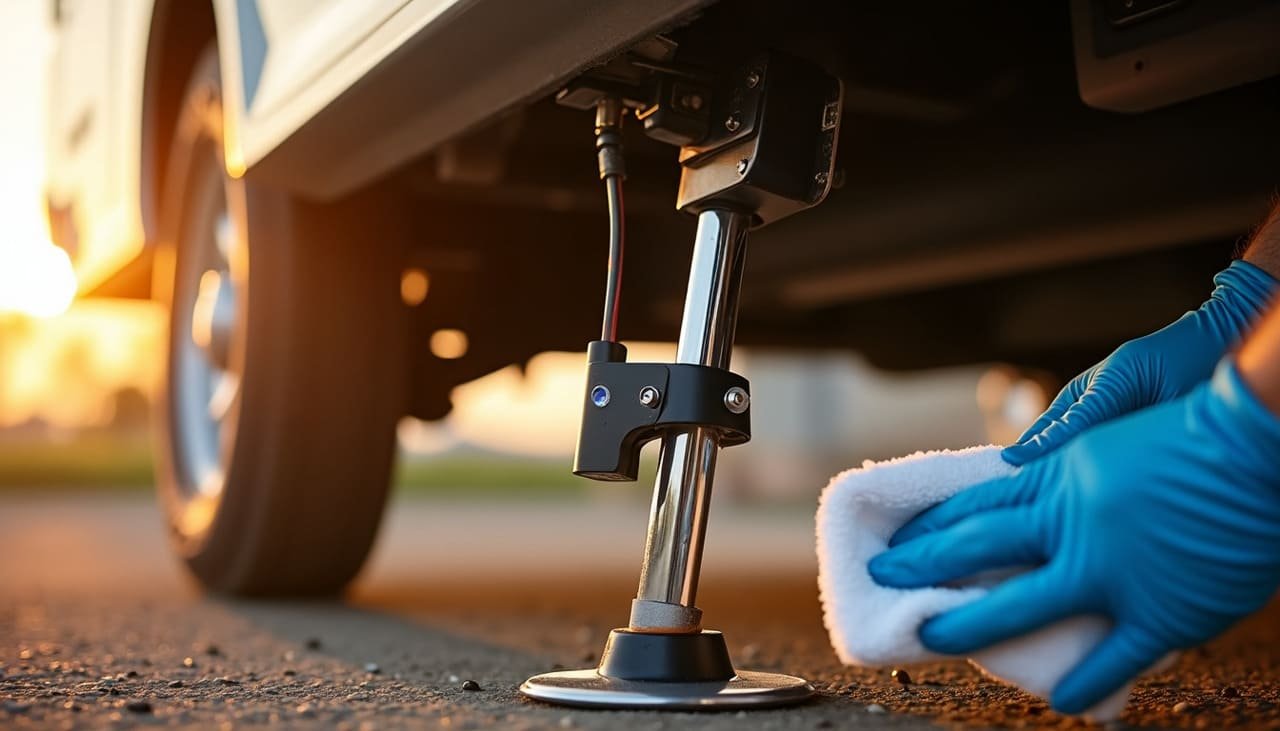

Leave a Comment